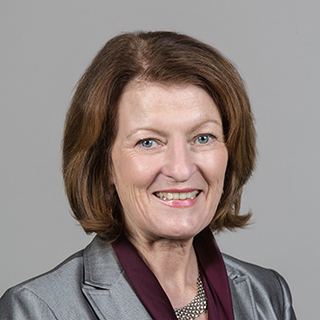To mark International Day of Older Persons this year, The Daily Scan spoke with Jane Murphy about her recent appointment as president and CEO of the Providence Residential & Community Care Services Society (PRCC), a new society dedicated to seniors care.
Can you tell me about your background?
I started my career as a nurse at bedside and loved that experience, having worked in a variety of clinical areas. Eventually, I was drawn to management and health administration. I had the privilege of working in both the US and Canada, which is interesting because the approach to care and concern for residents and patients is the same. However, the systems are different in terms of funding and access. I enjoyed working in both countries, including having most recently served as president and CEO of St. Joseph’s Hospital in Comox on Vancouver Island.
What drew you to the role of president and CEO for PRCC?
Given my background in Catholic healthcare in both the US and Canada, I saw this new role as a good fit for my values. During my tenure with St. Joseph’s Hospital, I was always impressed with Providence Health Care and developed a strong relationship with them. Before I stepped away for a year of semi-retirement, I was involved in some of the early discussions about changes to St. Joseph’s, including how we could best provide outstanding care to seniors. The ultimate outcome was the decision to create a non-profit organization, PRCC, whose foundation is built on the history and talents of both Providence Health and St. Joseph’s in Comox. Having seen the incredible work that was done during my year’s absence, I feel honoured to have been selected as PRCC’s CEO. I look forward to leading this new society.
For readers who don’t quite understand the distinction between Providence Health Care and PRCC, can you briefly explain it?
PRCC is a separate non-profit organization established with the goal of focusing on, and being committed to, providing excellent and innovative care for seniors. PRCC has its own board of directors and is now working to create a separate management structure, but will remain closely aligned with Providence Health over time.
Why was it necessary for Providence Health to create PRCC?
With a vision of innovation and excellence in seniors care, having an organization with a singular focus on this work was needed. At times, the demands of acute care are so overwhelming that, in order to do justice for our vision for seniors care and revolutionize the way we provide services for them in our care homes, we determined that a separate organization can best support this vision.
You have a lengthy history of working on behalf of faith-based organizations. What special quality do you think a faith-based organization offers that others perhaps don’t?
Faith-based organizations have always been of interest and importance to me, including carrying on the legacy of the Catholic sisters. Through their hard work and focus on community, they created beneficial services. That history resonated with me and the values remain relevant today. Faith-based organizations take time to think about values, talk about them, and hold themselves accountable to them. I appreciate their values of compassion and social justice, how they help populations traditionally underserved have a voice.
You most recently served as president and CEO of St. Joseph’s Hospital prior to the development of PRCC. How do you like being part of a new organization with a broader reach?
Being part of an organization with a mission of innovation and excellence in delivering seniors care – and exploring the potential ways to do that – is truly exciting. This is not new work, but having a lens focused wholly on seniors care is really needed, particularly for those in long-term care and those with dementia. How can we work together to make the remaining years of their lives the very best they can be?
The last we heard, a dementia village was planned for Comox. With the St. Joseph’s The Views transition completed, what are the next steps?

Artist’s rendering of future dementia village
Since the announcement last January by Health Minister Adrian Dix, the Ministry of Health, PRCC and Island Health have been actively engaged in discussions to advance the Comox dementia village project. A full project proposal has been developed based on the dementia village concept of smaller households with a common living and dining area to enable meaningful engagement in the daily activities of living. Each senior will have her or his own bedroom and bathroom, and access to secure outdoor space, allowing freedom of movement. Planned amenities include a bistro, a community hall, a convenience store and child care to promote intergenerational programming and integration with the community. The dementia village facilitates a social model of care, but with the flexibility and capability to serve seniors with dementia and complex medical problems.
What will be PRCC’s presence in Vancouver?
Within Vancouver, Providence Health currently operates five long-term care residences and one for assisted living. Those homes will eventually transition to PRCC. PRCC will also develop a dementia village at the St. Vincent’s/Heather campus. Like the Comox project, the design features of this village will reflect our philosophy of care, offering residents as much independence as possible.
In a recent interview, you stated that PRCC’s goal is to change long-term care from an institutionalized medical model of care to one based on a home-like environment for residents and patients, connected to their neighbourhood and community. Why do you think this hasn’t been done sooner? And can you provide an example of what this will look like?
Progress has been made and we’ve seen changes over the decades. For example, if you go to Providence Health’s long-term care homes now, you’ll see residents who want to get up at 5 a.m. and have breakfast and those who want to sleep in. We strive to support their preferences in all of our care homes. The question is how do we accelerate this and how do we support our staff in this important work, and provide the physical space that enables this entire philosophy? It’s about changing culture and this doesn’t happen overnight. As we age, many of us want to stay at home. But should we need long-term care, we want to be able to look at the care and services offered and say I would be happy and comfortable living there.





